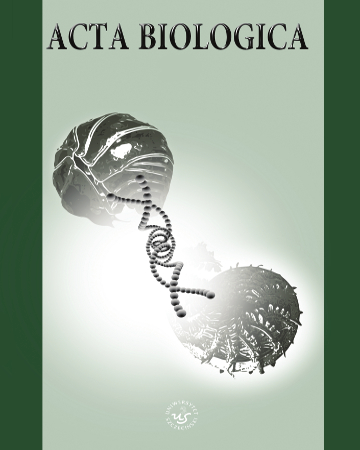
ISSN: 2450-8330
OAI
DOI: 10.18276/ab.2017.24-06



Lista wydań /
No. 24
QS – systems communication of Gram-positive bacterial cells
(Systemy komunikacji QS w komórkach bakterii Gram dodatnich)
| Autorzy: |
Alicja
Ziemichód
University of Szczecin, Department of Genetics, Faculty of Biology Bogumiła Skotarczak University of Szczecin, Department of Genetics, Faculty of Biology |
| Słowa kluczowe: | quorum sensing bakterie Gram dodatnie cząsteczki sygnałowe ekspresja genów kompetencja Streptococcus pneumoniae i Bacillus subtilis wirulencja Staphylococcus aureus |
| Data publikacji całości: | 2017 |
| Liczba stron: | 6 (51-56) |
Abstrakt
U bakterii Gram dodatnich komunikacja od komórki do komórki, zwana także guorum sensing
(QS) jest przede wszystkim zależna od zewnątrzkomórkowych sygnałowych oligopeptydowych
feromonów, które stymulują odpowiedź także pośrednio poprzez aktywowanie dwuskładnikowych
fosforanów lub bezpośrednio przez wiązanie efektorów cytoplazmatycznych.
Wytwarzanie i wydzielanie feromonów oligopeptydowych jest inicjowane w odpowiedzi na
specyficzne czynniki środowiskowe lub stres. Feromony są syntetyzowane różnymi drogami
a niektóre mają jeszcze dodatkową funkcję chemiczną jako wynik modyfikacji potranslacyjnej.
W komórkach Bacillus subtilis i Streptococcus pneumoniae ten system kontroluje nabycie
stanu kompetencji, natomiast u Staphylococcus aureus reguluje wirulencję. Celem pracy był
przegląd aktualnych danych dotyczących peptydozależnych dróg komunikacji.
Pobierz plik
Plik artykułu
Bibliografia
| 1. | Aggarwal, C., Jimenez, J.C., Lee, H., Chlipala, G.E., Ratia, K., Federle, M.J. (2015). Identification of quorum-sensing inhibitors disrupting signaling between Rgg and short hydrophobic peptides in Streptococci. MBio, 3 (6), e00393–15. |
| 2. | Cheung, G.Y., Wang, R., Khan, B.A., Sturdevant, D.E., Otto, M. (2011). Role of the accessory gene regulator agr in community-associated methicillin-resistant Staphylococcus aureus pathogenesis. Infection and Immunity, 79, 1927–1935. |
| 3. | Cook, L.C., Federle, M.J. (2014). Peptide pheromone signaling in Streptococcus and Enterococcus. FEMS Microbiology Reviews, 3 (38), 473–492. |
| 4. | Gordon, R.J., Lowy, F.D. (2008). Pathogenesis of methicillin-resistant Staphylococcus aureus infection. Clinical Infectious Diseases, 46, S350–S359. |
| 5. | Jaworski, A., Serwecińska, L., Stączek, P. (2005). Quorum sensing – bacterial cell-to-cell communication using chemical signal molecules. Advances in Cell Biology, 32, 231–256 (in Polish). |
| 6. | Jimenez, J.C., Federle, M.J. (2014). Quorum sensing in group A Streptococcus. Frontiers in Cellular and Infection Microbiology, 4, 127. |
| 7. | Kleerebezem, M., Quadri, L.E., Kuipers, O.P., De Vos, W.M. (1997). Quorum sensing by peptide pheromones and two-component signal-transduction systems in Gram-positive bacteria. Molecular Microbiology, 24, 895–904. |
| 8. | Lee, M.S., Morrison, D.A. (1999). Identification of a new regulator in Streptococcus pneumoniae linking quorum sensing to competence for genetic transformation. Journal of Bacteriology, 181, 5004–5016. |
| 9. | Li, Y.H., Tian, X. (2012). Quorum sensing and bacterial social interactions in biofilms. Sensors, 12, 2519– 2538. |
| 10. | Lorenz, M.G., Wackernagel, W. (1994). Bacterial gene transfer by natural genetic transformation in the environment. Microbiological Reviews, 58, 563–602. |
| 11. | Lowy, F.D. (2003). Antimicrobial resistance: the example of Staphylococcus aureus. Journal of Clinical Investigations, 111, 1265–1273. |
| 12. | Miller, M.B, Bassler, B.L. (2001). Quorum sensing in bacteria. Annual Review of Microbiology, 55, 165– 199. |
| 13. | Monnet, V., Juillard, V., Gardan, R. (2016). Peptide conversations in Gram-positive bacteria. Critical Reviews in Microbiology, 3 (42), 339–351. |
| 14. | Painter, K.L., Krishna, A., Wigneshweraraj, S., Edwards, A.M. (2014). What role does the quorum sensing accessory gene regulator system play during Staphylococcus aureus bacteremia? Trends in Microbiology, 22, 676–685. |
| 15. | Papenfort, K. Bassler, B.L. (2016). Quorum sensing signal – response systems in Gram-negative bacteria. Nature Reviews Microbiology, 14, 576–588. |
| 16. | Paulander, W., Nissen Varming, A., Bæk, K.T., Haaber, J., Fress, D., Ingmer, H. (2013). Antibiotic-mediated selection of quorum-sensing-negative Staphylococcus aureus. MBio, 3, e00459–12. |
| 17. | Siepka, M., Gładkowski, W. (2012). The phenomenon of quorum sensing. Creative Science – Monograph, 3, 172–181 (in Polish). |
| 18. | Solomon, J.M., Lazazzera, B.A., Grossman, A.D. (1996). Purification and characterization of an extracellular peptide factor that affects two different developmental pathways in Bacillus subtilis. Genes & Development, 10, 2014–2024. |
| 19. | Vijayalakshmi, M. (2013). Quorum Sensing in Gram-negative and Gram-positive bacterial systems. NPTEL-Biotechnology-Systems Biology. Joint Initiative of IITs and IISc– Funded by MHRD. |
| 20. | Wolska, K.I. (2012). Bacterial transformation. In: J. Baj, Z. Markiewicz (eds.), Biologia molekularna bakterii (pp. 440–444). Warszawa: Wydawnictwo Naukowe PWN (in Polish). |